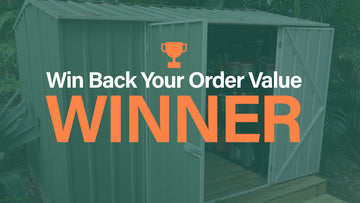
Building a garden shed might have never been part of the original plan and blueprint of your dream home. It might never have even crossed your mind in the past, but today, you woke up with an unexpected inclination towards arranging your things and keeping them organised, or you’re suddenly inspired to have a tiny room for yourself right outside the house.
Needing additional space is a common problem that homeowners overlook. Perhaps when you bought your home, you didn’t really think all the rooms would be occupied. Eventually, you bought a lawnmower and a bicycle. Then, you got a ladder and a shovel and decided to have a garden. You discovered a hobby. More people are moving in and kids are on their way. You’re surprised there isn’t enough space anymore. You want a room for yourself, but you don’t plan on moving out and finding a new place. You don’t want to have the house renovated.
However, there’s a way for you to conveniently have that extra room without spending too much. Building a garden shed allows you to maximise the area in your backyard and get the extra space you need without spending much. Here are some tips when choosing the best type of outdoor shed for your home.
Choose a shed that can serve multiple purposes
Right now, you might be quite sure of why you need a spare room, but you haven’t asked yourself if you will need the same space for other things and other reasons in the future. Thinking long-term will help.
You might have been looking forward to having your own workshop to accommodate a hobby you’ve grown fond of. Later on, you might want to have a centralised area for various equipment and decide to use the shed as an outdoor storage. Alternatively, you are probably currently using it as a mini-garage or a storeroom for your gardening tools, but tomorrow, you might wish to have a studio for photography.
If you know that your hobbies change from time to time or if you are the kind of person who enjoys redesigning and modifying things occasionally, you might need a more flexible design for your shed — one that would meet the wide range of your needs.
Be sure to consider that the material you’ll choose will suit your demands as they change over time. You might also want to make interior partitions to make this a multifunctional space.
Traditionally, outdoor sheds have been used as workshops, tool sheds, storm sheds, garden sheds, and storage sheds, but innovations are on their way. In the millennial age, people seem inspired to develop new ideas for their unused and unoccupied sheds. Today, old sheds are converted into tiny clubhouses, backyard bars, disco sheds, jamming areas for aspiring musicians and bands, and office spaces. It’s best to have an idea of the various needs you will have in the foreseeable future.
Choose an outdoor shed made of quality materials
The material you choose depends on what your purposes are and what you think they will be in the long run. The most common materials for sheds are wood, metal, resin, and plastic.
Quality steel sheds are common among Aussies whilst wooden sheds can be aesthetically-pleasing. It suits small gatherings and occasions and is also easy to customise, as wood can be cut and painted in specific ways. The downside is that you must maintain it annually. Some types of wood require being treated with wood paint on a regular basis. Some may also deteriorate faster than others.
In contrast, metal and steel sheds are sturdy and can withstand rain and harsh weather. Little maintenance is required after you finish building it. They also tend to be available in a variety of colours which match the exterior of your home or fencing.
Lastly, plastic types of sheds are easy to assemble, since they are lightweight. They also need little maintenance. However, they are not as easy to customise as wooden sheds and cannot be painted over.
Read product reviews and product specifications
It matters that you look into the product reviews. Social media can be a good source for them. Be sure to read feedback on the product itself, this will allow you to determine whether their customers have been satisfied with the product or not.
In addition, it is important for you to read the specifications of the material of your choice and the warranty terms of your supplier, as these vary widely among sellers.
Conduct a survey of your shed site
A thorough survey of your site is crucial before installing your shed. You should also consider the desired distance between it and your house. A building inspector may be helpful in this regard. At this juncture, you will have to know the type of foundation and soil you have in your backyard. A soil test will help you determine the necessary depth of your foundation.
You will need a deep hole for soft soil. You must also remove growing weeds or trees in your prospective area and be sure to level the ground for your foundation. In addition, you may want to consider installing weed-proof material before constructing the base of your shed. Clearing the area of debris, rubble, and dead leaves is essential to having a stable and sturdy base.
For your base, you might need to consider two things: do you want a concrete shed base, a raised timber floor or a gravel shed one? This depends on several factors, one of which is whether you want your shed in a temporary or permanent location. At some point in the future, you might want to dismantle your shed, either because you want to relocate it or replace it.
A concrete base is more suitable for a metal shed and is more permanent, it is best for securing your steel shed against the elements and also protecting from insects. If you’re planning a temporary shed, a gravel base is easier to remove. Gravel also costs less.
It is not recommended for you to install your shed directly on the soil because water seeps through the ground and exposes your base to moisture and corrosion. Plus, an uneven ground can cause your panels to be misaligned. This may make it tougher for you to close and open the shed’s doors and windows.
Consider the assembly and construction of your shed
You can either install and build your shed yourself or hire professional contractors to do the job. Today, DIY is becoming appealing. Sellers of shed kits and materials continuously modernise their products to make sheds easier to install without compromising their quality. Some sellers provide brief instructions, like a 5-step assembly, for convenient and efficient installation. There are also videos available online to help and assist you through the process.
If you have spare time and you need that space as soon as possible, assembling a steel or plastic shed might be best for you. Depending on your DIY skills and if someone is assisting you, it will probably take two days to complete the shed after you finish constructing the base.
An added value to doing it yourself is that you become more knowledgeable about your own shed and its peculiarities. Should you ever come across a problem, you most likely will know how to fix it yourself. On the other hand, relying on someone else to fix it for you may be time-consuming and costly.
Building your shed from scratch may sound intimidating if you are not a DIY enthusiast. However, like a puzzle or project, it can be fun and fulfilling after some time.
If you do not have much time but you have spare money, you feel that DIY is an unnecessary hassle, or you just want a better design and a specific theme, hiring professional contractors is an alternative.
Determine the right dimensions for your shed
Your shed’s height and width will depend on the items you plan to store in it and the users who will utilise it. If you plan on hanging equipment and tools, you might want to double check how sturdy your hooks are, especially if there are kids wandering around.
Underestimating storage space is a common mistake. After making an initial inventory of the things you need to store, you may have relied too much on the estimates you made and forgot to measure the items.
Since sheds come in different sizes, it is advised that you make accurate measurements of the items you intend to store in it. If you think you will buy large equipment that need to be kept safely, having double doors or a sliding door will suit you most. Also, there are sheds, like a bike shed, that are designed to function for a specific purpose or type of equipment.
It may seem trivial, but the shape of your shed’s roof matters. Sloping roofs not only keep the water away but also accommodate large equipment. If, say, you have several bicycles of different sizes, a sloping roof at the rear of your storage shed should be able to accommodate the larger ones whilst the smaller ones can occupy the front of the shed. It is also important to note that a watertight roof will be beneficial during months of bad weather. Metal sheds usually have side-coverings that keep the water out.
Consider the climate in your area
Condensation is a huge problem and is common in cold areas. However, hot and dry areas occasionally face this, too. Condensation means that moisture collects inside the shed. This eventually damages the interior of your shed and the items stored within, especially if they are prone to rusting. This may further result in the reproduction of harmful bacteria and moulds, as well as the infestation of insects. Poor ventilation and insulation also aggravate the situation.
Consider three things: summer heat, water leaks, and melting snow. If there is no proper ventilation, heat can cause the air to become damp and humid. Keep the air dry and the water out. There are several ways to do this: you may install an air-conditioning unit or an electric fan; you may also use dehumidifiers; or you may place calcium chloride around the shed’s perimeters.
Consider the initial cost and budget constraints
The best thing about steel sheds is that they do not cost as much as timber sheds. If you are working around a tight budget and having additional space is your top priority, a steel shed will be a good investment. You can purchase steel sheds for around $500. Also, hiring contractors definitely costs more than doing it yourself, but if you have extra money to spare, hiring them may be good.
Determine the legal requirements and restrictions for building a shed in your area
Permits for building a garden shed might be required by your council. This generally depends on the size of your shed, as small sheds are exempt from complying with application for a building permit or for a development application. Though there are general guidelines for compliance, it is still important to acquaint yourself with specific council regulations because they vary throughout Australia.
Consider the lighting, wiring, and the electricity for your shed
If you need lighting for your work or hobby, be sure to install windows in the proper places and that you choose a shed that can fit a wide window. If you enjoy working at night, you might want to prioritise wiring and electricity.
Consider whether you need a small lamp to give off enough light for a work table or if you need several pieces of equipment to run. Are you using this shed for the entire day, or are you just staying there to pass the time? Answering these questions will help you determine the proper way to wire your shed.
If you need electrical power on a temporary basis, an extension cord may be enough, but if your routine includes working at night, you might need permanent fixtures to protect your wires from rain and other elements.
Choose a shed that is easy to maintain and secure
You want to keep your shed safe from thieves and unwanted pests. Replacing your locks on a regular basis is advisable if you keep valuable items inside your shed. You should also conduct a routine check of the hinges of your doors and windows. Loose and old hinges are easy to unscrew.
In addition, you should ensure that rodents and other pests do not settle inside your shed. Watch out for cracks on the wall and on your floor. Make sure that you choose material that is easy to seal and repair.
Plan Ahead with EasyShed
Whatever reason and purpose you have for your shed now, you will never get disappointed about having one. A good source of quality shed kits and materials is available online: EasyShed supplies different types of sheds and offers great deals. Whether or not it’s your first time to purchase a shed, this online shop can give you what you need.








